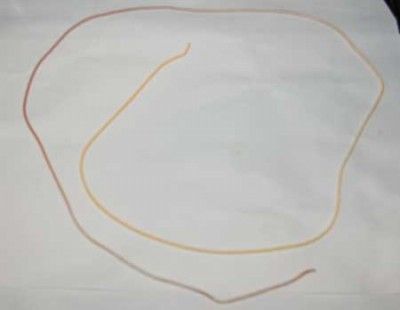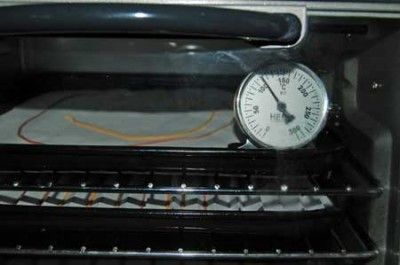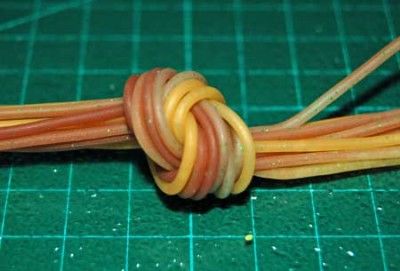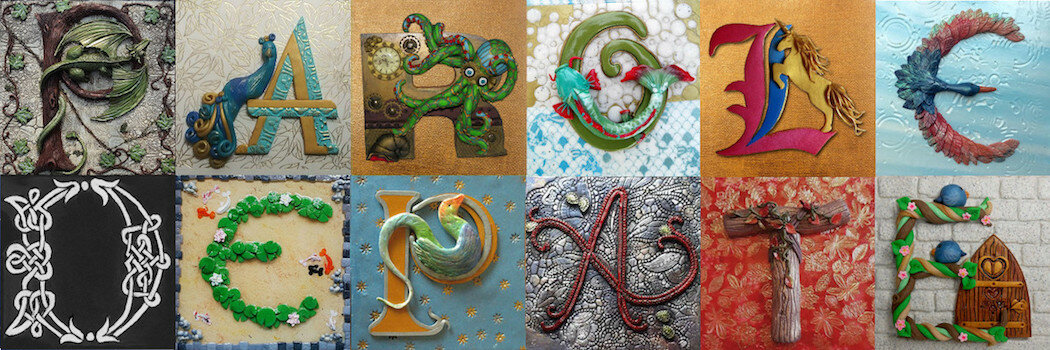Fimo Threads
by Moïse
This technique was born by chance: I was crafting a piece of jewelry made of translucent plates and I realized that fimo blocks remain slightly flexible after the cooking. Hence the idea of trying with threads, so I made researches in order to increase both the flexibility and the strength.
This is the fruit of my efforts and researches:
In order to realize colored flexible threads which are practically unbreakable you will need:
Some translucent fimo clay (with or without a color)
Some liquid fimo
Some soft fimo clay in different colors
Some pearl-ex in different colors
Some glittery in different colors
A clay gun and some white paper (for the cooking)
![]()
The technique :
There are different ways of proceeding, but the basic ingredient is the translucent fimo clay: the others (liquid fimo, pearl-ex, glitters and fimo soft) are meant only to soften and color it.
Basic technique:
Make some threads with one of the 7 translucent effects fimo clays (you can also mix them in order to obtain other colors) and cook them at the lowest degree suggested. You will already obtain a good result but next technique is definitely better.
Advanced technique:
Take one part of translucent flesh-colored fimo (014), the amount necessary to your needs (you can also use another color).
Pour
colorer le transparent on ajoute une petite quantité (maximum 5 %) de
pâte soft colorée ou un soupçon de perlex ou bien un peu de poudre
pailletée (suivant l’effet désiré, on peut associer les différents
ingrédients dans un même mélange ).
In order to color the translucent clay you can add a little bit (max 5%) of colored clay or just a pinch of pearl-ex or some glittery powder (according with the effect you wannt to obtain, you can also mix different ingredients in the same blending)
![]()
You mix in order to obtain a homogeneous clay (pay attention not to form any bubble):
You add to the mix you have obtained a little bit of liquid fimo and you mix again (it will be sticky, as the scrap clay). The liquid fimo will increase the flexibility and the resistance:
You put the clay you have obtained into the extruder, and you will make some spaghetti threads (you can use different diameters and different shapes, but you need to know that the thicker the thread the less flexxible will be the result, and viceversa):
Once the spaghettis are done, you will bake them: you put them onto a white sheet, being careful not to superpose them. You can also use an accordion sheet as in the picture:

For the baking: you start with a cold oven and you gradually arrive to 110°. Then you keep the oven at 110° for 30 minutes. When you put out the threads of the oven you plunge them into the cold water:
This is it: after the baking, you must be able to make a knot with the threads:
If, after the baking, your threads are breaking:
Either you haven't respected the baking mode
Or you have put too much colouring devices into your clay at the beginning (fimo soft, glitters, pearl-ex)
Or you have put too much liquid fimo
Or you have left air bubbles in the mix
I hope this tutorial will help you and will guide you towards new creative horizons.
Have a nice work and havefun!
This tutorial with images
is an intellectual property of its author.
Please, respect his/her
work and do not copy / reproduce / translate it without his/her
authorization.
Translated by Maria:
chiocciolazzurra@yahoo.it




/http%3A%2F%2Fstorage.canalblog.com%2F90%2F08%2F52426%2F62097160_o.jpg)
/http%3A%2F%2Fparoledepate.canalblog.com%2Fimages%2Ft-jadeite.gif)
/http%3A%2F%2Fstorage.canalblog.com%2F39%2F21%2F52426%2F64881048_o.jpg)
/http%3A%2F%2Fstorage.canalblog.com%2F80%2F65%2F52426%2F62755325_o.jpg)